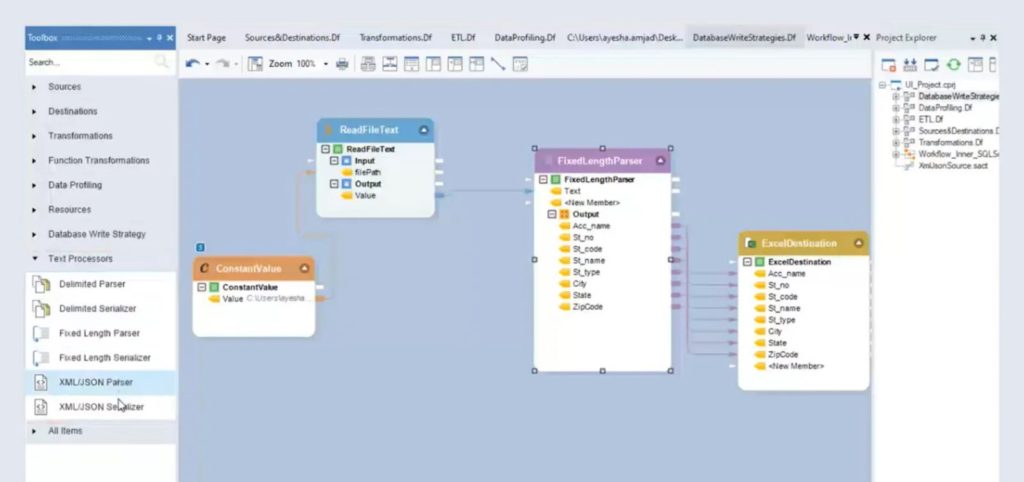Astera Intelligence
Update solution on November 25, 2024

Astera is a data management solution (see Figure 1) that provides data integration by enabling you to build ETL/ELT-enabled data pipelines. Data quality and data profiling capabilities can be provided as part of these pipelines, and other data management functionality, like data preparation and data warehouse automation, are also available. These capabilities are presented with a heavy focus on ease of use: virtually everything in the product can be achieved through a no-code interface, by dragging and dropping and/or pointing and clicking.

Moreover, the company has developed a collection of (generative) AI capabilities, which are presented together as Astera Intelligence. These are there for you to use within your pipelines, but are also implemented within the product itself in order to further drive usability and productivity. This includes LLM support.
Astera can be deployed on-premises or in the cloud, and includes various enterprise features, such as bulk loading, workflow and process automation, job/pipeline scheduling, failover, load balancing, role-based access control, and so on. In particular, various data governance functionality is available.
Customer Quotes
“Before Astera, it used to take anywhere between 30 minutes to a couple of hours to process a single invoice. Now, it takes less than a minute.”
VISN 9
“There are a number of products on the market which can do this, but we went with Astera because its interface is very user friendly. You can drag and drop components to pull data from any source and then manipulate either all of the data or individual fields the same way – I love that I don’t have to have someone fully trained in SQL code and SSIS in order to develop high quality solutions.”
Cherry Health
At its most basic, Astera enables you to build data (integration) pipelines through an intuitive, no-code interface powered by drag and drop (shown in Figure 2). These pipelines include data orchestration and mapping, and while a wide variety of prebuilt transformations and other pipeline components are provided to you, you can also build your own (again, without needing to write code). Custom components can be shared and reused as you would expect.

Both structured and unstructured data can be ingested into your pipelines, courtesy of the range of connectors built into the product. In addition, Astera provides API connectivity through REST APIs, while also including tools for API lifecycle management and for building any of your data sources – or a subset thereof – into secure, managed, real-time REST APIs, publishable to both internal and external users. Notably, these APIs are treated like any other pipeline component from a user perspective, and can be implemented into your pipelines just as simply as that implies. The other end of your pipelines can connect to a variety of databases, visualisation tools, and ERP/CRM systems. Pushdown optimisation is used to ensure transformations are performed in their optimal locations.
Data warehouse automation is also available, and speeds up the process of creating or migrating to a data warehouse by providing data modelling capabilities that allow you to map dimension and fact tables and then automatically load data based on those definitions. It also allows you to reverse engineer relevant data warehouse schemas, or push a schema to a target environment. Similarly, Astera pipelines are “self-adapting”: they automatically react to changes in their source(s), such as a change in schema, and adjust themselves accordingly in order to keep functioning.
Astera Intelligence, as mentioned above, is the collective name for Astera’s AI-powered capabilities. These are primarily used for two purposes: directly improving productivity, perhaps by automating an existing process, and enhancing usability, enabling your users to work more quickly and effectively (improving productivity indirectly). Several particular examples of AI, as used by Astera, are worth highlighting:
RAG (Retrieval-Augmented Generation) support is available via a selection of purpose-built components that can be placed within your pipelines and leveraged as with any other component.
Intelligent Document Processing (IDP) uses AI to automate data ingestion for documents. This works by automatically identifying the type(s) of data within the document, then creating and/or applying an appropriate data extraction and mapping template. In this way, data present in the document will be intelligently parsed and mapped to matching data fields. This process would normally need to be carried out at least somewhat manually to extract the data held within your documents, so automating it like this stands to save a potentially huge amount of work, especially if you have a large quantity of
documents to process (for instance, when digitizing an archive).
Astera Intelligence features a natural language, chatbot-style interface for building and/or modifying your data pipelines. This includes functionality for reviewing and verifying the pipelines built using this interface. This has obvious applications in both automation and usability.
You can incorporate generative AI directly into your data integration pipelines using Astera’s prompts-as-transformations feature. These are custom transformations that allow you to submit a curated but dynamic prompt – largely prewritten but parameterised based on your chosen input fields – to an LLM from within one of your pipelines, then have that pipeline act on predefined output fields contained within the response. This allows you to leverage generative AI systematically and automatically, without needing to be a data science professional. There is a caveat here: since LLMs are far from perfect – the hallucination problem, if it even can be solved, has certainly not been solved yet – it is highly recommended that any runtime use of this feature is either supervised by a human or extensively tested beforehand.
Astera promises the sort of scalability, performance, and resilience that you would expect from an enterprise data integration solution. Moreover, few of its competitors – if any – offer data warehouse automation alongside data integration, and its range of API functionality is impressive. That said, there are two areas where it really differentiates itself: usability on the one hand, and AI on the other.
In terms of usability, it is not unusual for products of this nature to feature drag and drop, no-code interfaces. Rather, what makes Astera stand out is the consistency with which it supports this kind of interface: almost everything, from pipeline components to APIs to LLM prompts, can be boiled down to an object to be placed on a canvas. This minimizes the number of interfaces that users need to learn while allowing them to take advantage of even advanced functionality quickly and easily.
Moreover, Astera’s usability is further enhanced by its AI capabilities, including the direct integration of LLM prompts into pipelines (as transformation components) and its natural language interface (although this is slightly at odds with the otherwise uniform application of its drag and drop interface). This frequently crosses over into enhancing productivity as well, such as with the aforementioned natural language interface, and most significantly with IDP, which stands to make your work much faster and easier if you are extracting data from documents.
The bottom line
Astera is an eminently easy to use, enterprise-ready data integration solution and data pipeline builder. It offers several broader data management capabilities – such as data quality, data profiling, and data warehouse automation – either within or without its pipelines, and its AI functionality, Astera Intelligence, is substantial and well-considered. In short, there is a lot to like about it.
Related Company
Connect with Us
Ready to Get Started
Learn how Bloor Research can support your organization’s journey toward a smarter, more secure future."
Connect with us Join Our Community
